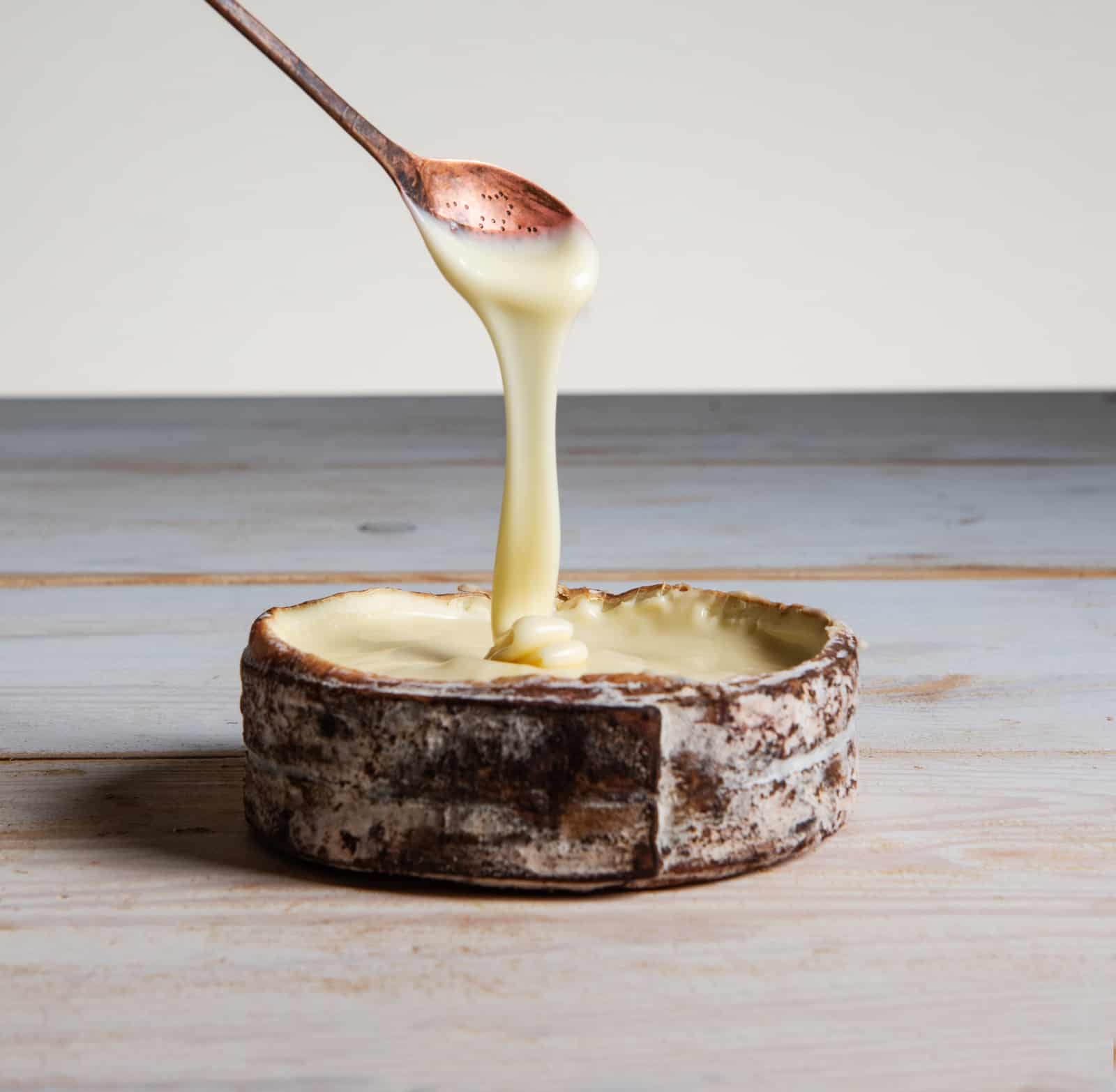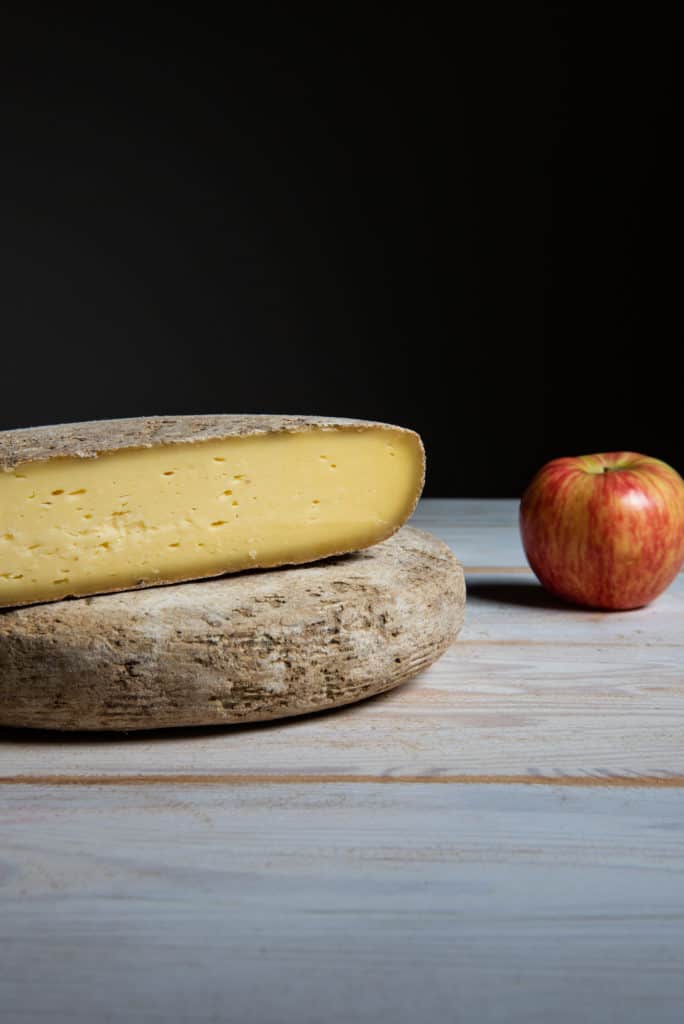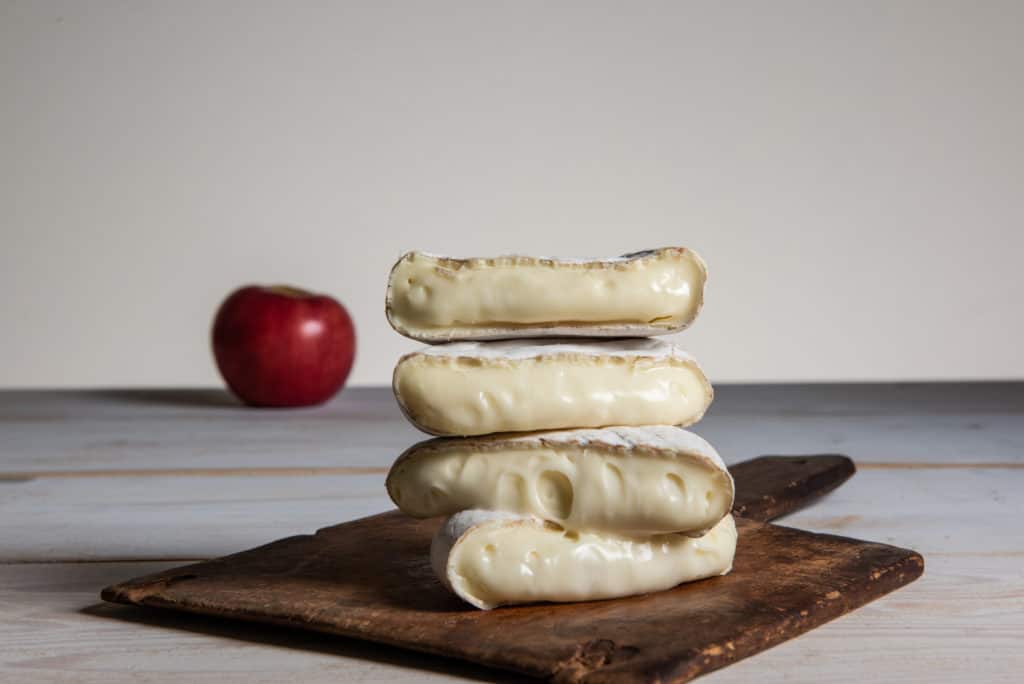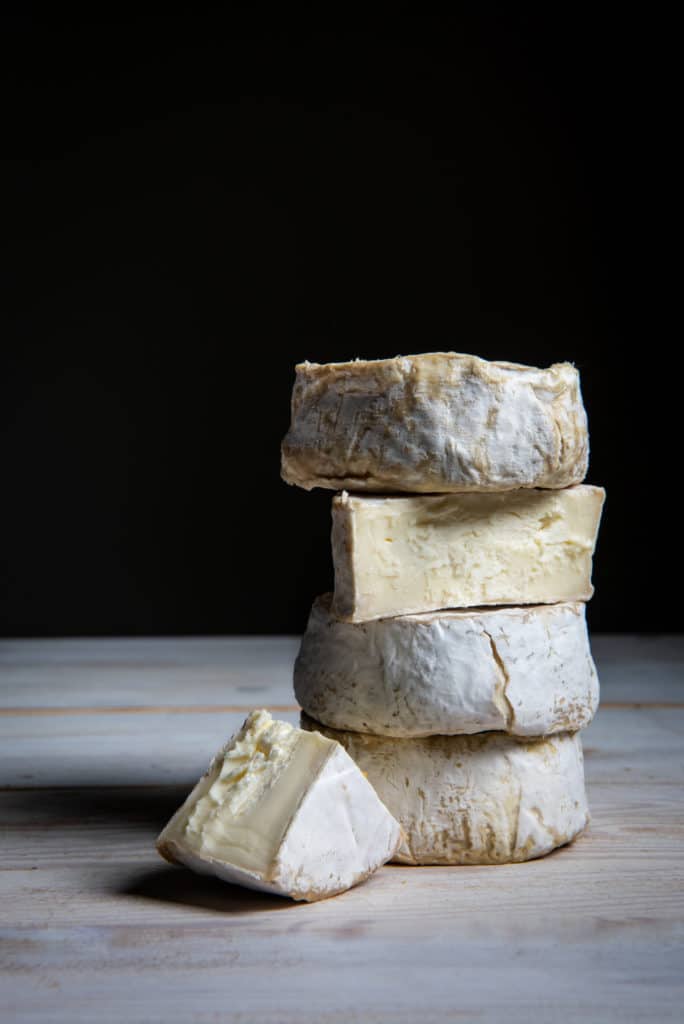
Greensward from Jasper Hill Farm/Murray’s Cheese.
While the unctuous paste of a washed-rind cheese owes its creamy character to the milky base within, its pungent surface soaks up flavor from outside. Since the Middle Ages, that’s been key to Trappist monks’ cheeses; combining their passion of booze-brewing with a penchant for affinage, the holy men have long bathed young cheeses in liquids like beer or brandy. Encouraging the growth of bacteria on wheel surfaces, the practice creates tacky orange rinds and moist environs for a pliant and pudgy paste.
Like many other Old World cheeses, this washed-rind style has crossed the ocean, colliding with new types of tipples and novel terroir. Modern stateside makers, ever ripe for experimentation, are washing wheels in whatever suits their fancy—and these days, it’s hard cider. The number of cidermakers in the United States has risen by 250 percent over the past four years, with styles that take cues from both beer and wine. Naturally, some of the most innovative cheesemakers are following suit, blending the monastic tradition of alcohol-washed wheels with local ciders to create cheeses that are distinctly American—and undeniably autumnal.
A cider-washed cheese is what it sounds like: a wheel that’s rubbed with hard cider as it matures.
Picking and Choosing
A cider-washed cheese is exactly what it sounds like: a wheel that’s rubbed with hard cider as it matures. It’s just like any other washed rind, only with fermented apple juice as a stand-in for the brine, beer, wine, or spirits traditionally used to flavor the round. When the cider is applied to young cheeses, its own unique microflora interacts with the bacteria on the wheels, while the autumnal elixir’s flavors of fermentation infuse into the rind and the paste.
When it comes to choosing a cider, the whole spectrum is fair game, from the fruity and easy-to-sip to much drier, funkier varieties. The wash itself can also vary; some cheesemakers opt for unadulterated hard cider, while others mix in brine or swirl in extra yeast, and still others experiment with silty cider by-products.
The simplest option is plain hard cider, a go-to for makers of cider-washed tommes like Humble from Vermont’s Parish Hill Creamery. After the wheels are formed and salted, they’re aged in an environment thick with native microflora: a repurposed root cellar that has held cheese for two decades. Like clockwork, every Monday, Wednesday, and Friday, makers at Parish Hill go through the cellar wheel by wheel with a bowl of hard cider, dipping a gloved hand into the liquid and then rubbing it onto the tops and sides of each cheese.
Rachel Fritz Schaal, who owns the creamery with her husband, Peter Dixon, explains that cider helps Parish Hill select for certain microbes. “We’re actually knocking back mold growth and providing nutrients for yeasts to grow,” she says. With all its washings—requiring an estimated cup of cider per four-pound wheel over the course of at least eight weeks—Humble develops notes of apple and a distinct yeastiness, since the low pH and alcohol of the cider encourage the growth of yeast as opposed to bacteria.

Humble from Parish Hill Creamery.
At Murray’s Cheese in New York City, though, cider gets an extra boost. A blend of cider, salt, and yeast comprises the wash for Greensward, a bark-wrapped cheese that’s sent down to the company’s cheese cave from Jasper Hill Farm in Vermont. It starts off as Harbison, Jasper Hill’s woodsy, cow’s milk bloomy rind. But after a month of aging and cider baths at Murray’s, Greensward grows into Harbison’s burlier brother.
According to Peter Jenkelunas, cave master at Murray’s, the addition of yeast removes bitterness from the cheese while also toning down its surface acidity, aiding in rind development. The result is a flavor bomb of buttery umami with an unctuous, pudding-like texture enclosed in its bark sheath.
Other makers use lees, a by-product of the cider fermentation process. Lees are created as live yeasts feed on the sugars from the maturing fruit, creating carbon dioxide and alcohol; as they die, the yeasts settle at the bottom of the tank. Otherwise filtered out and discarded by cidermakers, or sold to pig farmers as feed, cider lees can also find a home in cheesemaking.

Hartwell from Jasper Hill Farm.
Jasper Hill Farm sources lees from local producers—initially from Eden Cider, but now from Shacksbury Cider—to create Hartwell, a small-format, soft-ripened cheese.
Hartwell achieves balance between a cider wash and a bloomy rind. “We want that [bloomy] rind to develop,” says Olivia Haver, a washed rind specialist at Jasper Hill, “but for the lees to still impart some flavor.” On the nose, the yeasty mix lends Hartwell a pleasing waft of apple, while on the palate, those floral, fruity aromas meld with savory, buttery notes.
The lees are easy on the eyes, too. Unlike the classic blush-orange of most washed rinds, they give Hartwell a layered effect: a thin, red-orange hue beneath a downy rind. According to Haver, that’s because lees—which are more viscous than brine, beer, or plain cider—apply as a thicker wash. “You can see that layer [of lees] right underneath the white,” she says.
The smell of apples is synonymous with autumn, and that’s reflected in the cheese—a sweet, fruity familiarity that won’t scare anyone off.
An Elegant Experiment
Cider application achieves an accessible washed rind: it’s not overtly funky, tacky, or stinky, but rather lighter and more nuanced. Its first impression is on the nose. The smell of apples is synonymous with autumn, and that’s reflected in the cheese—a sweet, fruity familiarity that won’t scare anyone off.
“Aromatically, you can tell it’s there before you even take a bite,” says Padgett Arnold of Tennessee’s Sequatchie Cove Creamery of her cider-washed Nickajack. And while she aims for complexity in the paste—something not immediately identifiable as apple cider—the wash “is much more noticeable when you smell the rind.”

Nickajack from Sequatchie Cove Creamery.
“You get a glimmer of those subtle undertones, while still having a little funkiness of a washed-rind cheese.”
With aroma comes flavor, and if the cheese is washed enough times—say, a few times per week for three to four weeks, as with Pins & Nettles from Nettle Meadow Farm in Upstate New York—the flavors from the wash come through.
“We’re washing with cider from the outset,” says cheesemaker and co-owner Sheila Flanagan. Before the rind has really formed, she says, “we’re already starting to wash it with cider, so those subtler flavors will find their way not just to the exterior of the rind, but to the interior of the cheese.”
The Nine Pin Cider used to wash the firm yet crumbly cow’s and goat’s milk tomme lends a crisp fruitiness that’s elevated by the addition of sea salt and tarragon to the rind. The cider’s notes of ginger and pear combine with the cheese’s verdant herb coating for a flavor that’s delicate yet complex. (Pins & Nettles is then finished with a brushing of citrus vodka, which imparts a little zing and knocks down unwanted bacteria.)
For Flanagan, that’s the nice thing about cider: It strikes a balance between lightness and funk. She calls the result “elegant,” juxtaposing it with Nettle Meadow’s beer- or hard alcohol–washed cheeses, which are more assertive. With a cider wash, “you get a glimmer of those subtle undertones, while still having a little funkiness of a washed-rind cheese,” she says.

Nettle Meadow’s Pins & Nettles.
“It was an experiment that went right.”
At Brooklyn’s Crown Finish Caves, where underground affineurs experiment with a gamut of boozy washes, from beer to cider to sake, wholesale manager Caroline Hesse echoes Flanagan’s point. “Ciders can lend a less pungent stinky cheese vibe,” she says. “It’s more mellow.”
Crown Finish’s cider-washed cheese, called Gatekeeper, arrives in Brooklyn as a young mixed-milk triple cream from Old Chatham Sheepherding Company. As it ripens into a luscious little wheel, its flavors can range from fruity to vegetal to funky—it all depends on the wash. Over the years, affineurs here have experimented with maturing Gatekeeper using different ciders.
Its first iteration yielded a pleasant surprise. At the time, the cheese was washed in MillStone’s Farmgate—hence its name—a dry and earthy cider from Maryland. “It gave the cheese a really complex flavor, almost like ramps,” says Hesse. “It was an experiment that went right.” She notes, though, that those hints of allium in the cheese appeared only when the cider was used as a wash—sip the cider alone, and they weren’t detectable.
Currently Gatekeeper is washed in Graft Cider’s Farm Flor, a pleasantly sour cider from New York. Fruitier than Farmgate, though still not super juicy, the rustic, barrel-aged libation pushes the cheese in a funkier direction—less allium and more sweet, it’s not the same Gatekeeper as before. But that’s what keeps the process exciting. “It’s fun to see how the cheeses respond,” says Hesse.
“There are apple orchards everywhere, and there still are. In keeping with our philosophy, there had to be a hard cider.”
A Little Local
The idea of terroir is par for the course in artisanal cheese. But for makers in regions where both cider and cheesemaking traditions flourish, incorporating cider into cheese takes the notion of terroir a step further.
At Vermont’s Parish Hill Creamery, Peter Dixon and Rachel Fritz Schaal’s cider-washed Humble was born from the romantic idea of reviving centuries-old practices. The pair operate with a philosophy of using only ingredients they make themselves—including homegrown starter cultures—or that come from as close by as possible (salt from Maine, rennet from Quebec). “As Rachel says, we do things the most difficult way possible,” Dixon quips.
So when searching for the perfect wash for Humble, cider was an easy choice. It seemed obvious given Vermont tradition—plus, Dixon had been making his own cider for years, inspired by fruit wines made by friends and the dandelion wine he’d learned to make from his mother.
“I thought about what was going on here 100 years ago. They didn’t make beer; they made hard cider,” he says of Southern Vermont’s green hills and the brewing traditions that thrived here before Prohibition. “There are apple orchards everywhere, and there still are. In keeping with our philosophy, there had to be a hard cider.”

Gatekeeper from Old Chatham Sheepherding Company/Crown Finish Caves.
“It seemed like a natural area of collaboration.”
Nearby cidermakers echo similar sentiments: Taking advantage of the local bounty is of utmost importance. “Each area has its own microflora, and I think it’s important to bring what’s local to create a memory of that space,” says Kyle Sherrer, who launched New York–based Graft Cider with his sister, Sara, after founding and owning Millstone Cellars with his father.
At Graft, Sherrer draws inspiration from European cidermaking while using New York apples, pursuing styles that are more reminiscent of experimental craft beers. Beyond the flagship Farm Flor used to wash Crown Finish Caves’ Gatekeeper, for example, their Lost Tropic cider is infused with citrus and Citra hops, while the seasonal gose-style Peaks & Valleys is spiced with cinnamon, birch, and anise.
For Sherrer, the focus is less on the apple varietal—which is what some cidermakers focus on with a oenologue-like perspective—and more on the yeast and the bacteria that live on the surface of the fruits. Likening cider fermentation to the work of cheese cultures, Sherrer is enthusiastic about collaborating with another microbe-focused industry. “It’s fun to see what happens when you put those two things together,” he says.
Farther north in Vermont, Shacksbury Cider co-founder David Dolginow sees the great food products of Vermont as milk, maple syrup, apples, and cider. Over years working in the Vermont food community, Dolginow got to know local cheesemakers, of which, of course, there are many.
With a focus on apple diversity and flavor complexity, the Vergennes-based cidery now provides both cider and lees to nearby cheesemakers. Over the course of its five-year existence, Shacksbury has partnered with many cheese producers—from Jasper Hill to Twig Farm, a mere 20 miles away in West Cornwall, to Consider Bardwell Farm or Von Trapp Farmstead, and even Brooklyn’s Crown Finish Caves. Together, they create a taste of the region.
“There’s such a prolific cheese tradition that stems from the agricultural landscape here,” he says. “It’s well-suited to grazing animals, and those soils are great soils for apple trees. It seemed like a natural area of collaboration.”
Tasting Notes
Humble
Parish Hill Creamery
Putney, Vt.
Raw cow’s milk
Though it starts off mild and grassy, with a distinct smell of yeast and apple skins, this Vermont cheese gets funkier with age, developing a mushroom-like savor and a slight tang.
Pins & Nettles
Nettle Meadow Farm and Artisan Cheese
Warrensburg, N.Y.
Pasteurized goat’s and cow’s milk
Tarragon, sea salt, and a kick of citrus set off the fruitiness from local cider for a washed-rind wheel that’s delicate and nuanced.
Gatekeeper
Old Chatham Sheepherding Company / Crown Finish Caves
Old Chatham, N.Y. / Brooklyn, N.Y.
Pasteurized cow’s and sheep’s milk
Tart, funky cider lends a kiss of sweet acidity that perfectly perks up the luscious paste of this small-format triple cream.
Nickajack
Sequatchie Cove Creamery
Sequatchie, Tenn.
Raw cow’s milk
Ruddy-rinded Nickajack yields a waft of fresh apple aroma that’s tempered by a full-bodied, meaty flavor and a lingering earthiness.
Hartwell
Jasper Hill Farm
Greensboro, Vt.
Pasteurized cow’s milk
Approachable and creamy, Hartwell intensifies as it ripens, picking up notes of alliums that are tempered by soft, floral fruit flavor.
Greensward
Jasper Hill Farm / Murray’s Cheese
Greensboro, Vt. / New York, N.Y.
Pasteurized cow’s milk
Beneath a blush-hued rind and spruce wrapping, Greensward’s spoonable paste booms with pungent flavors of meat and broth and fleeting notes of leaves, resin, and ripe fruit.
Photography by Beryl Striewski



